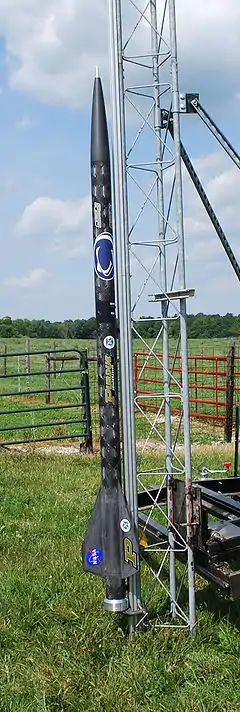ALICE (propellant)
ALICE is a rocket propellant which consists of nano-aluminium powder and water. After mixing, the material is frozen to keep it stable. Hence, the name ALICE, for ALuminium ICE rocket propellant.
Aluminium has a stronger affinity for oxygen than most elements, which is most visible in aluminothermic reactions such as thermite. This allows aluminium to burn with a large release of heat in substances that one normally considers to be inert, such as carbon dioxide and water. However, aluminium combustion is normally hindered by the presence of a durable oxide layer that forms on the surface of aluminium particles, requiring significant heat to overcome. Additionally, aluminium oxide condenses out of the exhaust stream at high temperature, leaving it (and its heat of condensation) unable to contribute to expansion unless there is another gas present to function as a working fluid. This generally has relegated aluminium's role in rocketry to that of being an additive to solid rocket propellants, increasing their density and combustion temperature and stabilizing the burn.
The oxide layer in nano-aluminium powder, however, is thinner and easier to overcome than in that of larger particles. This makes the combustion of aluminium with water ice easier to ignite and sustain. Furthermore, as the aluminium consumes the oxygen, it liberates hydrogen which functions as a low molecular mass working fluid to translate the heat of combustion (and subsequently condensation) into expansion and thrust. The high density of the mixture allows for reduced tankage mass and high thrust.
The base combustion reaction is:[1]
- 2 Al + 3 H2O → Al2O3 + 3 H2
ALICE has been proposed as a propellant well suited for in-situ production on outer space bodies such as the moon, as both aluminium oxide (a source of aluminium) and water are abundant resources in the universe, while the high propellant density decreases the dry mass of the rocket. Maintaining the propellant in a frozen state is relatively simple on most bodies in the solar system, while other high performance propellants often involve cryogenic fluids that can pose long-term storage problems.

See also
References
- Miller, Timothy; Herr, John (2004). "Green Rocket Propulsion by Reaction of Al and Mg Powders and Water". doi:10.2514/6.2004-4037. Cite journal requires
|journal=(help)
- Aluminium-Ice (ALICE) Propellants for Hydrogen Generation and Propulsion, Risha et al., 45th AIAA/ASME/SAE/ASEE Joint Propulsion Conference & Exhibit, August 2-5, 2009
- NASA, AFOSR test environmentally friendly rocket propellant, Eurekalert August 21, 2009
- AFOSR and NASA Launch First-Ever Test Rocket Fueled by Environmentally-Friendly, Safe Aluminium-Ice Propellant
- How to Make a (More) Environmentally Friendly Rocket Fuel, September 11, 2009
- Aluminium Fuel Could Power Future Space Trips
External links
- University-produced development and flight video, Purdue and Penn State students, August 2009
